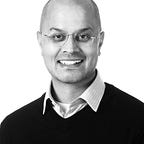The S-Curve: Musings on Technology, Professional Career, and Investments
S-Curves have provided a good mental model for product adoption, product market fit, and start-up growth. At the core, the adoption of new products starts slow, accelerates rapidly (with the right product-market fit), and then plateaus. The journey is marked with emotions, from hope, hysteria, to doom. This post is not about emotions. Like products, the mental model of S-Curve is equally applicable to career and investments.
It’s particularly important when the world around us is changing at a rapid pace. One viewpoint is the time it took for a given product to reach 50 million users. 68 years for Airlines to 19 days for Pokemon Go. While it’s not an apples to apples comparison, digitization, software, and new business models are shrinking the adoption timeframe across many industries.
My background has been in the climate-tech and biotech sectors; and both have witnessed profound changes in the past decade or two. A few data points:
- The cumulative installed capacity of solar increased from 1.2GW in 2000 to 633GW in 2019. While cleantech 1.0 timeframe focused on gen 1.0 solar — e.g. improving solar cell efficiency, the current gen 2.0 solar is part of the building block of the energy services that companies like Enphase and SolarEdge are building.
- 14GWh of lithium-ion capacity was installed in 2014, and it grew to 198GWh by 2017. With a gigafactory a week being built in China, the pace of installed capacity will only continue.
- As the cost of sequencing a human genome dropped from $100 million in 2000 to less than $1000, we’re witnessing the growth of new applications, e.g. liquid biopsy, NIPT gaining more adoption.
While not Pokemon Go level adoption, the above mentioned technologies and products have gained 100x or higher adoption in less than a decade.
There are similar trends that are brewing for a few other technologies, which move from the hope to rapid adoption in a few years.
- Hydrogen — with the use of hydrogen thus far limited to niche applications (e.g. forklifts), we’re witnessing bold policy actions by several countries, larger applications (e.g. heavy transport, renewables) becoming at or below cost parity. It’s not surprising that many analysts predict that the hydrogen economy will be multi-trillion dollars by 2050.
- Li-ion battery recycling — with the convergence of robotics, AI, and the fact that less than 5% of the batteries are recycled, its’ creating ripe opportunities for recycling of li-ion batteries. Coupled with the fact that by 2030, it’s projected that 26 million Electric Vehicles (EVs) will be bought globally, there will be a ‘supply’ of 1.7 million metric tons of used batteries. Expect to see economical use of these from second-life batteries to mineral recovery to become more important.
- Energy + Mobility — the convergence of these two sectors (a topic which I wrote here as well) will become stronger; primarily driven by energy storage. The ying-yang of product innovation that improves EVs, also will become more important in the energy services, from backup power to grid services.
These are just a few examples; but for a company to continue growing it’s important to not only preserve the core business / product, but at the same time plant seeds to hop on to the next S-Curve when the product plateaus. In addition to traditional R&D, we should expect more thoughtful innovation strategies (and yes, some wandering) to incubate and grow new businesses / products outside the Core.
While the S-Curves in technology are well known, the applicability of the same in career is seldom discussed. In the previous generation, it was not uncommon to start at {insert your favorite company name} after graduation; and it would not be far fetched to map out the career trajectory until retirement, likely from the same company. The world and technology is not static anymore. These factors will necessitate the need for continuous learning and upskilling. Platforms like Udacity, Coursera provide numerous options based on one’s desires, and the new ones are also focusing on a given sector., e.g. terra.do for climate. As a result, unlike a single-career S-Curve in the previous generation, odds are professionals today will be on multiple-career S-Curves over their professional career, across industries and functions. Career as a product. For this, lets’ call it Career-Market Fit (CMF), the learning will not stop at the universities, but instead it will be a continuous process as one moves from one S-Curve to the next.
And lastly, the intertwining of S-Curves from different domains will open up new investment opportunities. The rapid progress in Synthetic Biology and Robotics opened up new forays in material science (e.g. Zymergen, Ginkgo Bioworks). Similarly, in the energy sector, the progress in Computer Vision and AI/ML opened up new avenues for inspecting power lines. As an investor, understanding the second or third order effects of various technologies will provide unique and attractive opportunities.
So, in the world that’s becoming more dynamic and we’ve large problems to be solved, if you’re:
- At a Large Company — how are you investing in your innovation programs? How are you developing your portfolio to grow your Core but also incubate along the edges?
- An Individual — what new skill will you learn to solve for your Career-Market fit?
- An Investor — how might the second and third order effect of technology convergence inform or change your investment thesis?
I look forward to your comments and continuing the conversation.
